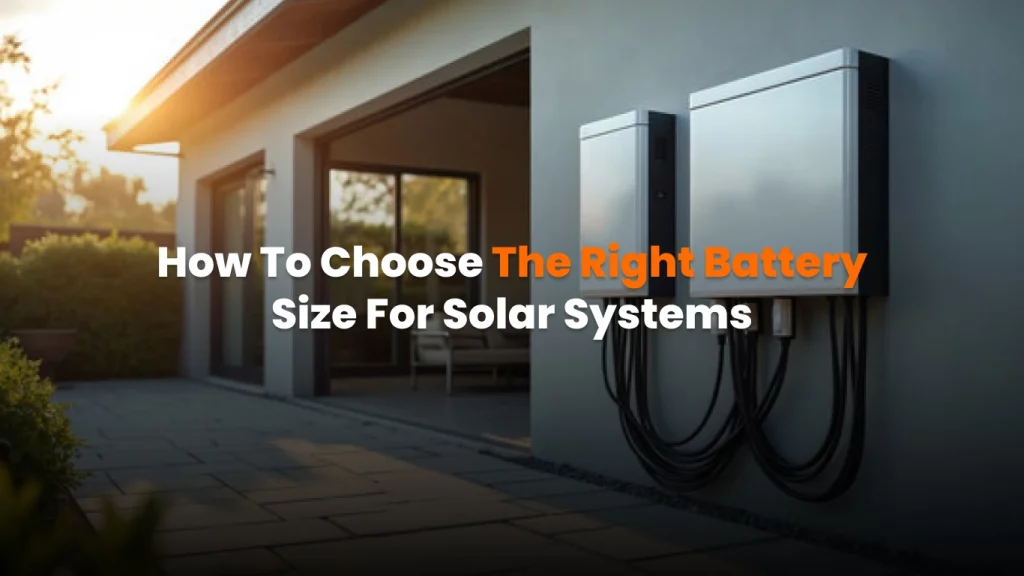When building a solar power system, batteries are key, whether you’re preparing for off-grid living, seasonal blackout protection, or daily load balancing. But how do you know which battery size best meets your energy needs? This guide walks through essential terminology, step-by-step sizing methods, battery type comparisons, system configurations, and practical sizing formulas so you can make informed decisions.
Battery basics: capacity, depth of discharge, and watt-hours
Understanding the factors influencing battery size is crucial for optimizing your solar power system’s performance and efficiency.
Factors Influencing Battery Size
Let’s start by clarifying a few terms:
- Capacity: Usually presented in amp-hours (Ah), this measures how much charge a battery holds. But what matters more is its energy content, expressed in watt-hours (Wh), calculated by multiplying capacity by voltage (e.g., a 100 Ah battery at 12 V holds 1,200 Wh).
- Depth of discharge (DoD): The portion of a battery’s total capacity you actually use. With lead-acid technologies, an effective DoD is typically limited to 50%, while lithium-iron phosphate (LiFePO₄) batteries can safely use up to 80–90%.
- Usable energy: Your real usable energy is battery capacity × voltage × DoD. This is the number you want to match to your needs.
Calculating your energy needs
Sizing starts with understanding your energy use:
- Add up your appliance loads (in watts) and estimate hours of use per day to get daily watt-hours.
- Add a 20% buffer for inefficiencies like inverter loss, temperature effects, and aging.
- Divide the adjusted watt-hours by battery voltage to find required amp-hours, then correct for DoD.
Example: Running a 100 W load for 5 hours consumes 500 Wh. At 12 V, that’s about 42 Ah. For a lithium battery at 80% DoD, you’ll need at least 52 Ah to deliver that much usable energy.
Understanding system configurations
You can shape your battery bank for desired voltage and capacity using combinations of batteries:
- Series wiring increases voltage (e.g., two 12 V, 100 Ah batteries in series give 24 V at 100 Ah).
- Parallel wiring increases capacity at the same voltage (e.g., two 12 V, 100 Ah batteries in parallel give 12 V at 200 Ah).
- Series-parallel wiring lets you scale both voltage and capacity.
Types of batteries: lead-acid vs. lithium-iron phosphate
Three major battery types are commonly available:
- AGM and gel (lead-acid): Affordable, proven, but limited by lower DoD (50%), shorter cycle life (∼500–1,000 cycles), and weight.
- LiFePO₄ (lithium-iron phosphate): Higher initial cost, but deeper cost efficiency thanks to high DoD, low degradation, longer life (3,000–6,000 cycles), and lighter weight.
Step-by-step battery sizing formula
Let’s walk through a complete example:
- Daily power usage: 2,000 Wh.
- Add 20% inefficiency buffer: 2,400 Wh.
- Battery voltage: 12 V.
- Required amp-hours: 2,400 Wh ÷ 12 V = 200 Ah.
- With LiFePO₄ at 80% DoD: 200 Ah ÷ 0.8 = 250 Ah.
You’d need at least a 12 V, 250 Ah battery bank.
For higher-voltage systems (e.g., 24 V), the amp-hour requirement halves: 2,400 ÷ 24 = 100 Ah ÷ 0.8 = 125 Ah.
Planning for growth and real-world factors
A few practical tips:
- Oversize for future needs: If you plan to add loads like an EV charger, building capacity now saves headache later.
- Power storage at higher voltages: A 24 V or 48 V system uses thinner cables and handles energy more efficiently than a 12 V bank.
- Account for harsh climates: Cold and heat can reduce battery performance—so add a buffer or buy insulation.
- Lead-acid batteries should only be discharged to 50%. So for 2,400 Wh usage, you’d need a ≈ 400 Ah lead-acid bank at 12 V.
Comparing battery choices
| Factor | Lead-acid | Lithium (LiFePO₄) |
| Depth of discharge | 50% | ~80–90% |
| Cycle life | ~500-1,000 cycles | ~3,000-6,000 cycles |
| Usable kWh | Lower | Higher |
| Weight / space | Heavy, bulky | Lighter, more compact |
| Cost per usable kWh | Higher total | Lower over lifecycle |
Real-world application examples
- Mobile setup: Power laptop (60 W), lights (40 W), and fan (20 W) for 4 hours a day—total 480 Wh. With buffer, 576 Wh ÷ 12 V = 48 Ah. At 80% DoD, pick at least a 60 Ah 12 V lithium battery.
- Home backup: A refrigerator (200 W) and Wi-Fi router (15 W) for 12 hours draws 2,580 Wh. With 25% inefficiency buffer, you need 3,225 Wh ÷ 12 V = 269 Ah ÷ 0.8 = 336 Ah battery. That’s a substantial bank—typically multiple modules in series or parallel.
Whether you’re powering a small cabin, a family home, or a large off-grid system, choosing the right battery size can make all the difference in performance and reliability. The right setup not only ensures your energy needs are met but also protects your investment for years to come. Take the time to calculate your daily usage, plan for backup capacity, and match your batteries to your solar system’s capabilities.




